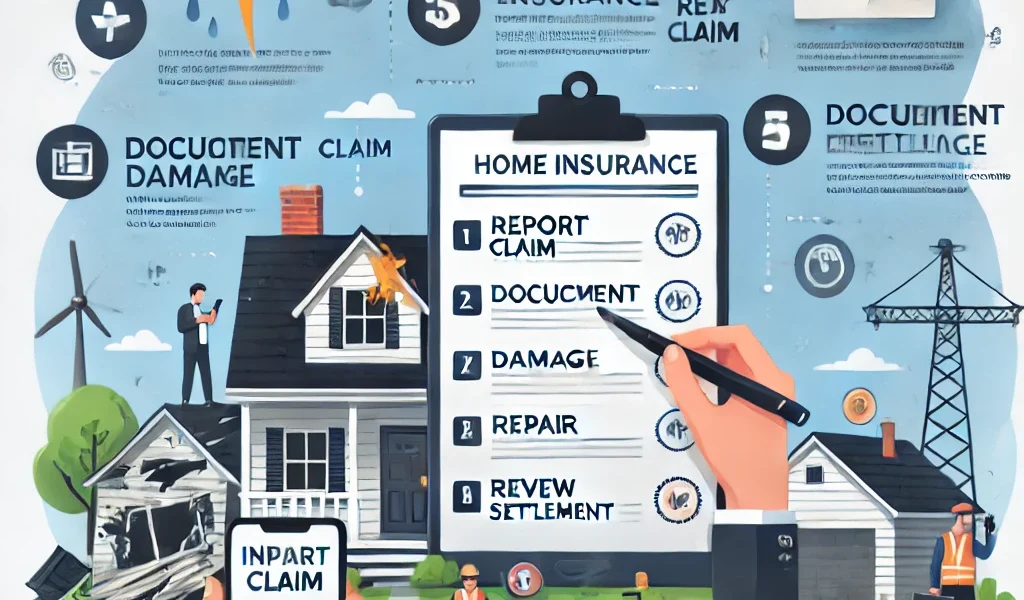Natural disasters such as hurricanes, earthquakes, floods, wildfires, and tornadoes can cause extensive damage to homes. If you have home insurance, filing a claim can help you recover financially and rebuild your property. However, the process of filing a claim can be complex and requires careful documentation.
In this comprehensive guide, we will walk you through the step-by-step process of filing a home insurance claim after a natural disaster, ensuring that you receive the compensation you deserve without unnecessary delays or complications.
Step 1: Ensure Safety First
- Before inspecting damage, ensure that your home is safe to enter.
- If the property is severely damaged, wait for authorities to declare it safe.
- Take necessary precautions, such as wearing protective gear, to avoid injuries.
Step 2: Review Your Insurance Policy
- Check your home insurance policy for coverage details.
- Verify what types of natural disasters are covered (some policies exclude floods and earthquakes unless specifically included).
- Review deductibles, limits, and additional living expense (ALE) coverage for temporary housing.
Step 3: Document the Damage
- Take clear photos and videos of all damaged areas before making any temporary repairs.
- Capture both interior and exterior damage.
- If possible, provide before-and-after images to support your claim.
- List all damaged or destroyed belongings with estimated values.
Step 4: Notify Your Insurance Company Immediately
- Contact your insurer as soon as possible to initiate the claim process.
- Provide details of the disaster, including date, time, and extent of damage.
- Ask for the specific documents required to file the claim.
- Request a copy of your policy if you don’t have one.
Step 5: Make Temporary Repairs to Prevent Further Damage
- Cover broken windows, leaking roofs, and exposed areas with tarps or plywood.
- Save receipts for all repair materials, as they may be reimbursable.
- Do not start permanent repairs until the insurance adjuster inspects your property.
Step 6: Meet with the Insurance Adjuster
- Your insurer will send an adjuster to assess the damage.
- Be present during the inspection to provide documentation and answer questions.
- Walk through the property with the adjuster and point out all damages.
- Request a copy of the adjuster’s report for your records.
Step 7: Submit Your Claim and Required Documents
- Complete and submit the insurance claim form provided by your insurer.
- Include:
- Photos and videos of the damage
- List of damaged items with estimated values
- Receipts for temporary repairs
- Proof of ownership for high-value items (if available)
- Keep copies of all submitted documents for reference.
Step 8: Understand the Settlement Offer
- The insurer will review your claim and offer a settlement based on policy coverage.
- If the offer seems too low, negotiate and provide additional evidence.
- Consider hiring a public adjuster for an independent assessment if necessary.
Step 9: Receive Payment and Begin Repairs
- Once you accept the settlement, your insurer will issue payment.
- The payment may come in multiple installments for different aspects of repair.
- Hire licensed contractors for permanent repairs and renovations.
- Keep all receipts and documentation for final claim reconciliation.
Step 10: Appeal If Your Claim Is Denied
- If your claim is denied, review the insurer’s reason carefully.
- Provide additional evidence or request reconsideration if you believe the decision is incorrect.
- If necessary, consult an insurance lawyer or file a complaint with the insurance regulatory authority.
Tips for a Smooth Home Insurance Claim Process
- Keep a Home Inventory: Maintain a list of all belongings with photos and receipts.
- Understand Exclusions: Know what disasters are not covered and consider additional policies if needed.
- Communicate Clearly: Keep detailed records of all conversations with your insurer.
- Be Patient but Persistent: Claims processing can take time, so follow up regularly.
Frequently Asked Questions (FAQs)
Q1: How long does it take to process a home insurance claim?
Processing time varies by insurer and claim complexity, but most claims take 30-60 days.
Q2: What if I need emergency housing?
Check if your policy includes Additional Living Expenses (ALE) coverage, which reimburses temporary housing costs.
Q3: Can I choose my own contractor for repairs?
Yes, but ensure they are licensed and provide detailed repair estimates to your insurer.
Q4: Will filing a claim increase my premium?
Filing multiple claims within a short period may increase premiums, but one claim due to a natural disaster may not.
Q5: What if I don’t agree with the insurance adjuster’s estimate?
You can request a second opinion from a public adjuster or negotiate with additional evidence.
Final Thoughts
Filing a home insurance claim after a natural disaster requires careful documentation, prompt communication, and persistence. By following this step-by-step guide, you can ensure a smooth claims process and receive fair compensation for your losses.
Understanding your policy, keeping accurate records, and knowing your rights will help you navigate the claim process efficiently. Be proactive, stay informed, and take necessary precautions to protect your home and financial future.




